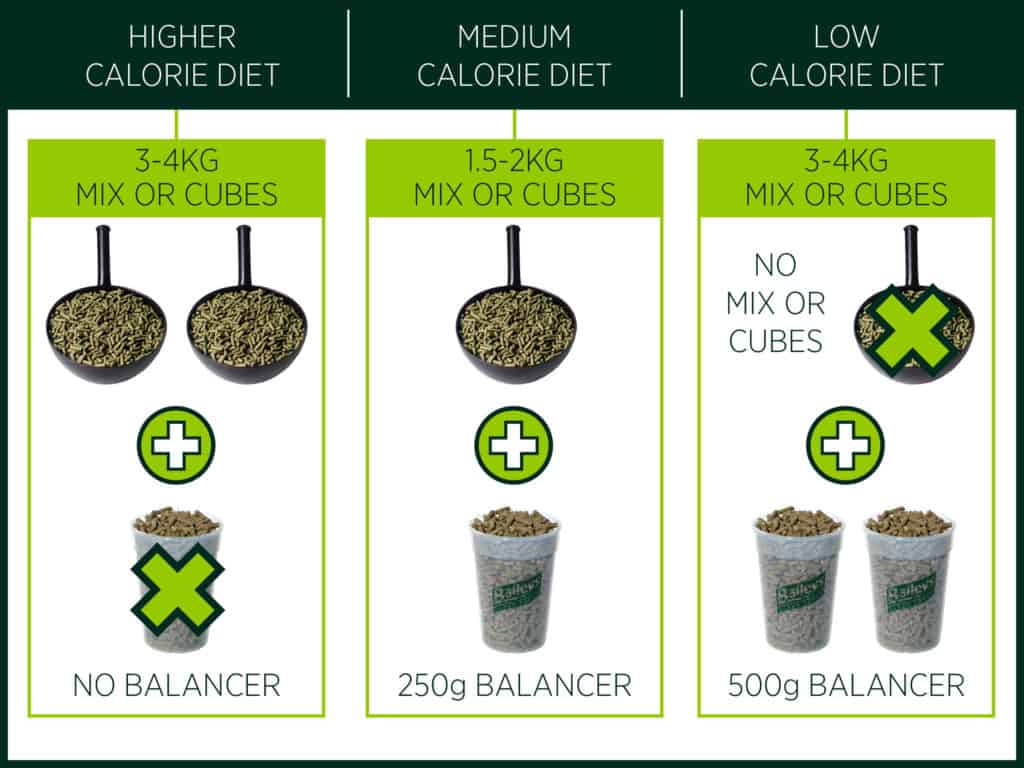Are you wondering how you can adjust your horse’s diet to better match his workload? A common problem, particularly as we head into winter, Baileys Horse Feeds is on hand to help

Matching your horse’s diet to his workload involves supplying the calories and nutrients he needs to maintain the desired body condition and fuel his work, while also keeping his diet balanced at all times. Sound like a tricky balance? With a little bit of forethought, it doesn’t have to be.
Fully balanced
Modern compound feeds are all formulated to be fed at calculated levels according to work intensity and alongside forage of a recognised average nutritional quality. Feeds are designed to supply nutrients that are lacking in that forage, plus additional calories when appropriate, and so provide a fully balanced diet. The nutritional content of forage will vary according to type and time of year, but typically it can be expected to provide calories from fermentable fibre and soluble carbohydrates, plus other nutrients, including protein, vitamins and minerals, whose levels vary and are often lacking. This means they ideally need supplementing, regardless of your horse’s workload.
As workload increases, your horse’s requirements for vitamins, minerals and protein increase, too. So, even if he’s managing to meet calorie requirements from a combination of stored body fat and forage, his diet will need to be adjusted to meet these growing nutritional needs. Protein, for example, is the main component of muscle and body tissue, and is often supplied in limited amounts by conserved forages – hay and haylage – so working horses, particularly those whose physique we’re looking to improve, will require appropriate supplementation.
Vitamins and minerals
These are involved in many of the metabolic processes throughout the body, including the release of energy from food. Meanwhile, minerals are also vital components of body tissues, including bone and muscle. It’s not just the levels of these nutrients in the diet that matter, but also the form in which they’re supplied, which determines how easily your horse’s body can absorb them from his food and subsequently utilise them. Feeds formulated for higher workloads often contain chelated minerals, which are attached to proteins or other molecules to make them more easily absorbed and available to your horse, meaning he can utilise more from every mouthful.
Practicalities
If your horse or pony is currently eating nothing but grass or forage and is maintaining or gaining condition, introduce a balancer to supply what’s lacking without unwanted calories. For example, choose Baileys Lo-Cal if your horse is at rest or in light work, and Performance Balancer for moderate to hard-working horses. Assuming you feed the full recommended amount of your balancer, if you need to increase your horse’s calorie intake slightly you could choose an appropriate mix or cube, again formulated for your horse’s workload, and gradually introduce the type of calories that best suit your horse’s temperament.
Varying calorie levels
As you build up to, say, 25% of the recommended amount of your chosen mix or cube, you can reduce the amount of balancer you feed to 75% of its recommended amount – and so on. The chart below gives a guide as to how you can then combine a mix or cube with your balancer to vary the level of calories your horse’s diet supplies, while also maintaining the correct balance of all other nutrients. This way, by keeping a careful eye on your horse’s condition and energy levels, you can adjust his diet throughout the year to ensure he looks and performs at his best.

This example will maintain a fully balanced diet for a 500kg horse in moderate work. This is a broad guideline and it’s worth checking amounts with a nutritionist if you’re unsure.
Balancer plus
Another way to vary calorie levels, while maintaining a fully balanced diet, is to feed the full recommended amount of an appropriate balancer and add additional calorie sources, chosen to deliver quick- or slow-release calories, accordingly. This approach can suit well when only low levels of additional calories are required, especially if you’re unlikely to need to feed the full recommended amount of a mix or cube.
Straight cereals, such as oats, can be fed to provide quick-release calories, while highly digestible fibre sources, including alfalfa or soaked beet pulp, provide slow-release calories. Oil or high oil additives, such as linseed, also provide slow-release energy, although additional antioxidants should be provided when feeding oil sources in greater quantities. A high oil supplement, such as Baileys Outshine, already contains these antioxidants to support your horse’s utilisation of the oil.
Winter fibre
Heading into winter, preserved forages will play a greater part in your horse’s diet and should ideally be fed ad lib, because grass quality and quantity tails off. As the main calorie source for good-doers, however, intake may need to be controlled to avoid weight gain or to encourage weight loss. For poorer-doers, especially those who aren’t great forage eaters, additional fibre sources or forage alternatives, such as Baileys Alfalfa Plus Oil, soaked Speedi-Beet or Fibre-Beet or Fibre Plus Nuggets, can be fed separate from the hard feed to increase overall fibre intake.
For more information, head to baileyshorsefeeds.co.uk















